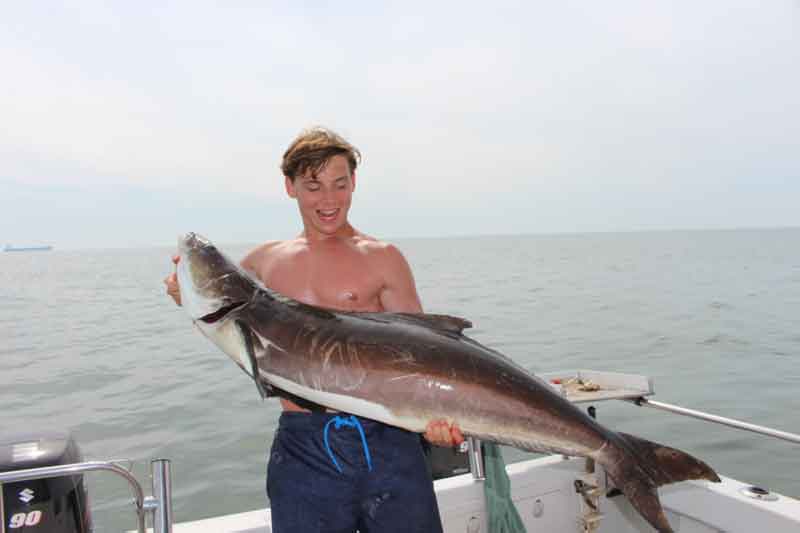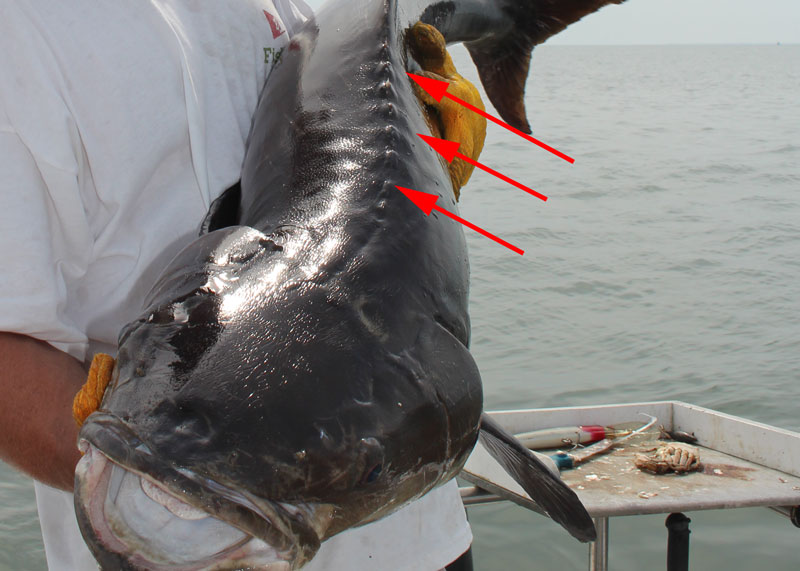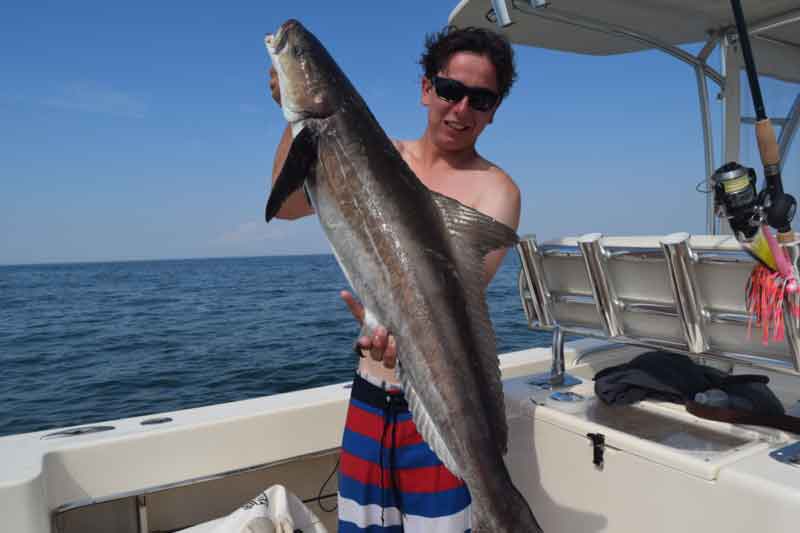Cobia are unique among the species searched out by anglers who enjoy Chesapeake Bay fishing, because of their massive size and tremendous strength. Fishing for cobia can be tough, but any angler who catches one of these big boys can always be proud that they wrestled in a fish so powerful. Plus, they are great fun to fish for sport and excellent eating as well. If bragging rights and dinners aren’t enough bait for you, citations are awarded to anglers who catch cobia over 55 pounds in Virginia or 44 inches in Maryland.

What are Cobia Fish?
Cobia are the only member of the Rachycentridae family. There are two migratory stocks of cobia: the Atlantic cobia and Gulf cobia. The species is found anywhere between Massachusetts to Florida, and in the south they roam through the Bahamas and the Gulf of Mexico. As a temporal migratory fish, they will spend winter in southern waters and swim up to us in the Mid-Atlantic region for summer. Usually they appear in good numbers off our coast in May and in the Bay in June, and remain in the area until the weather begins cooling off in the early fall.
As mentioned before, cobia can be rather enormous. Cobia fish have an average length of three to four feet and their weight can range between 10 pounds up to 100 pounds. They can be recognized by their elongated torpedo-shaped body and broad, flat head. Cobia have a funny looking lower jaw that protrudes slightly from the upper jaw and is full of fibrous villiform teeth lining the jaws, tongue, and roof of the mouth. Don’t let that alarm you, although they should be handled with care. They also have a row of sharp dorsal spines that anglers have to watch out for when fishing for cobia, because they're quite stout and can do some damage if the fish starts thrashing in the boat. These dorsal spines are actually why cobia have their family name which is derived from the Greek words for “spine” and “sting”.

Other identifying information for cobia is that they have a smooth, dark brown body with white on the belly and two darker horizontal bands on the flanks. During spawning, their stripes are more noticeable because they darken and the brown body color lightens. With their large, sharp, pointed bodies, cobia look like a small shark in profile and it’s no wonder they're often mistaken for sharks when first spotted.
Record Cobia
Given that even the average cobia is pretty dang big compared to most fish in the Bay, of course it takes a real monster of a catch to set a record. Here are the biggest recorded cobia that have been caught in the Mid-Atlantic region:
Delaware – A 79 pound, six ounce cobia was caught by John Burbage on August 10, 2018 at Ocean View.
Maryland – The record is held at 97.8 pounds by John Scheifele, from September 12, 1969, at the Middle Grounds.
Virginia – The largest record of the Mid-Atlantic sits at a whopping 109 pounds, with the spot held by Joseph F. Berberick, who caught his record cobia in 2006 at York Spit.
Cobia Seasonal Availability
The key to figuring out the seasonal availably of cobia fish is to follow their migratory habits. Atlantic anglers are in luck here because when Atlantic cobia migrate north, they also move inshore, making it easier to reach them. For anglers in the DelMarVa region, the best time to fish for cobia is from early summer through late summer. However, this does not mean cobia fishing is open all the time. States set their own seasons based on their allocation as cobia migrate differently for each area. This means that open season for cobia is subject to change annually.
Keeping up with spawning seasons doesn’t hurt either, as this is often a time when cobia swim together near the surface, the perfect opportunity to sight-fish for them. In the Chesapeake Bay, cobia spawn between June and August. Peak spawning happens in July. Pay attention to the Way South Chesapeake and VA Fishing Report to know when cobia start hitting in Virginia. Keeping an eye on the Lower Bay reports will let you keep track of the fish as they move north through the Virginia portion of the Bay, and eventually up into Maryland waters.

Cobia Fishing Regulations
The Atlantic migratory group of cobia fish are managed by the Atlantic States Marine Fisheries Commission (ASMFC). The ASMFC website has information about the management of cobia including stock status and links to management plans. There’s a lot there so for a broad outline remember that recreational harvest is limited to one fish per person, and two per boat in the Chesapeake Bay (with only one above 50 inches, at the time of this publication) plus state-specific seasons and no-gaff regulations.
These rules do change so be sure to check for the latest information on cobia fish regulations by state; visit these websites:
Where to Find Cobia Fish
Cobia are a eurythermal species so they can tolerate a wide range of temperatures, but they do prefer warmer waters. They move into nearshore waters when water temperatures reach 68 to 77 degrees Fahrenheit. They are also structure-oriented and often gather around reefs, wrecks, and buoys. Many anglers recommend looking for cobia around shoals. And they also like floating structure, including flotsam but even large rays or sea turtles. In fact, many sight anglers keep on the lookout for rays and try to spot cobia around them.
Are you looking for hot spots to find cobia? Here are some good ones that regularly show up in our fishing reports:
- The Grandview and Buckroe Beach areas of Hampton near the mouths of the Lower Bay rivers.
- The Middle Grounds near the Chesapeake Bay Bridge tunnel, and the close-by Eastern Shore shoals and edges (such as Latimer, the Cabbage Patch, and the edges along Cape Charles Reef).
- Off the Rappahannock River, from Windmill Point to Stingray Point; you can read Fishing the Rappahannock River for more detailed information on how to be in charge of cobia here.
- Smith Point to the Target Ships, one of the northernmost areas to fish for cobia in Virginia as they migrate up the Bay; read Top 10 Potomac River Hotspots for tips to fish in this area, and also check out chart 3 in Point Lookout to Smith Point which has a map marked with the most productive spots for cobia fishing in the Point Lookout/Smith Point area.
- The Target Ships and nearby reefs and edges is a favorite for both Maryland anglers running south, and Virginia anglers running north.
- Any of the numerous shoals along the coast from one to 10 miles from shore, from Fenwick Shoal all the way down to Nautilus Shoal at the mouth of the Bay.
How to Fish for Cobia
The three most popular methods of cobia fishing include: sight-fishing, chumming, and trolling. Cobia are one of the few fish that are popular for sight-fishing in the Mid-Atlantic region because when they swim near the surface they’re relatively easy to see. Plus, they are curious creatures that like to hang around people’s boats, buoys, and other flotsam, making it all the easier to sight-fish for cobia. Sight-fishing is more difficult, however, because cobia are usually the least hungry when they’re near the surface, but that’s no problem if you want a challenge. Chumming, on the other hand, is much easier to master, and is highly effective. To get the full scoop on each of these methods, read The Cobia are Coming. This article has detailed tips on sight-fishing and chumming, and a helpful video on how to fish for cobia (bonus: there’s a Killer Cobia Recipe included). For chumming in particular, check out this how-to video we shot on the Lower Bay in June of 2024.
Here are the basics you need to know to troll for cobia:
- Maintain a speed between four and six knots.
- Use 40- to 60-pound class gear.
- Let lines out 50 to 150 feet behind the boat, with a variety of offerings (see the section on Best Cobia Lures, below), with different sized weights so they run at different depths.
- Troll over shoals, channel edges, and reefs or wrecks.
- Since big cobia can be very difficult to control, when one is hooked up it’s a good idea to pull in the other lines and get them out of the way to prevent tangles.
Best Baits For Cobia Fishing
Live baits are generally considered the best baits for cobia, though when chumming cut fish or crab works well, too. That said, these are the top picks for cobia bait:
- Live eels
- Live spot or bunker
- Cut bunker
- Soft or peeler Crabs
Be sure to carry a mix because you never know what the fish will want on any given day. When we shot that video above we had both bunker chunks and eels deployed, and the eels never even got hit. Other days, it seems like eels are the only thing they'll eat. You just never know!
Best Lures for Cobia Fishing
- One- to three-ounce bucktails dressed with twister tails and/or large plastic teasers are a good choice for sight fishing. Bright colors like white, chartreuse, and pink are often most effective.
- Surgical hose eels are usually the top pick for trolling, with pink, green, and red colors usually proving a good choice.
- Spoons of three to six inches are sometimes used for either trolling or casting. Some people like to keep some smaller spoons in the mix when they troll, so they also have a good chance of catching Spanish mackerel or bluefish, which are often in the same areas.

Check out our Live With Lenny video all about cobia fishing on the Chesapeake Bay.
Be sure to checkout our entire Fishing for Beginners series, to learn more about the basics of fishing in the Chesapeake Bay and Mid-Atlantic region.
Editor's note: This article was originally published in July of 2020 and was last updated in June of 2024.
-By Hannah McGee